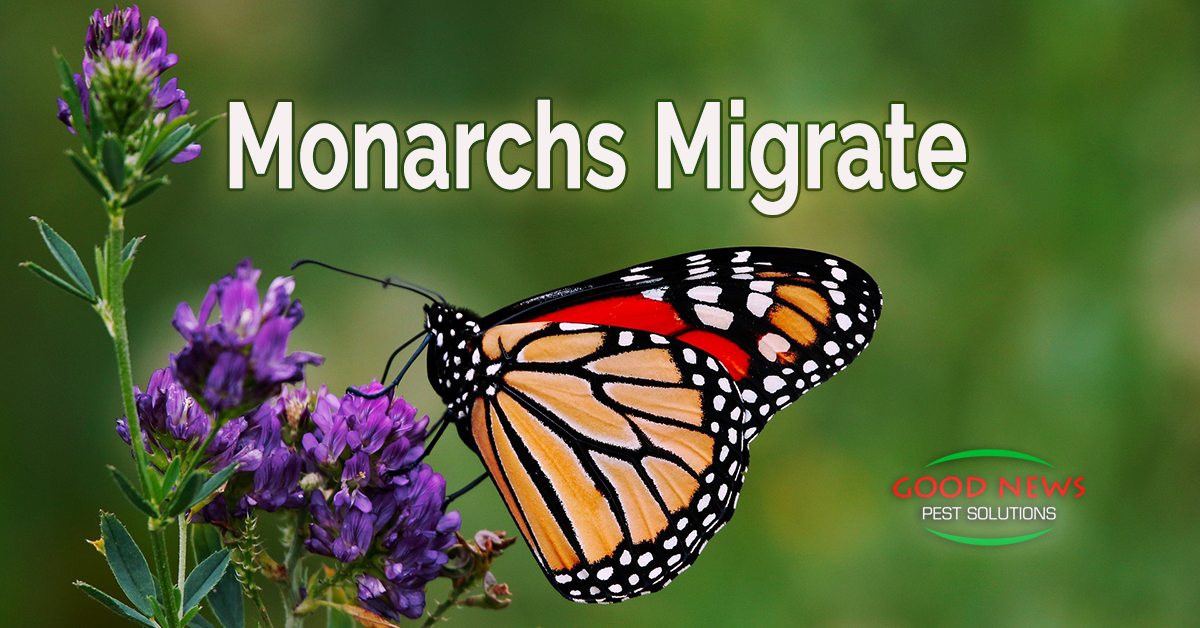
Monarchs Migrate
As September winds to a close, we look forward to another of our more unusual seasons here on the Gulf Coast of Florida. While we won’t see the weather drastically cooling and many leaves falling off the trees, we do get the benefit of those seasonal changes happening elsewhere. Soon, swarms of orange and black butterflies will fill our air – as the annual Monarch Butterfly Migration happens.
Mexico stays even more temperate than we do, so thousands of butterflies will begin taking flight from areas as far north as Canada and, on their way to the land of Montezuma, we get to enjoy the colors they bring to our scenery.
Go South-West Young Man
Because butterflies need to take rest stops on their journey, they travel to Mexico through three routes – California, Texas and, of course, Florida. That is where they will find the nectar of flowering plants to sustain them on their multi-thousand-mile aerial voyages.
In recent years, some have even journeyed more directly – thanks to oil drilling rigs, they have a place to pause and can shoot across the gulf, rather than sidestepping (side-flying?) down the panhandle.
And researchers say there are some groups of lepidoptera who skip the Sierra Madre mountains and Yucatan peninsula, opting for Caribbean islands, or even stopping short to enjoy the nightlife of Miami.
Since the early 1970’s scientists and volunteers have been tagging the Monarchs to better understand just how they make their migratory expedition.
Endangered Ecology
Unfortunately, one of the other things scientists have noted in recent years is the dwindling numbers of Monarch butterflies – and not because they took a left turn at Albuquerque. For a variety of reasons, fewer and fewer butterflies are available to make the trip south – and even fewer stay.
For years, entomologist Lincoln Brower studied Danaus plexippus, their migratory patterns and shared his knowledge of butterfly conservation to raise awareness. Unfortunately, since his death in 2018, only a couple of minor entomologists have taken up his cause. Dr. Marc Minno at the University of Florida and Nick Bodven in Ft. Myers are both actively involved but say there isn’t much support for butterflies in Florida.
Developmental Issues
One of the biggest issues threatening the butterfly population is the reduced quantity of and access to milkweed. Those long green stems with purplish pink flower pods are the only place where Monarch butterflies lay their eggs.
Unfortunately, milkweed plants are often seen as more of a weed or nuisance flower, often mowed down, pushed back for more construction, or killed off with pesticides. The climate changes, both big and small that we’ve seen over the past 40 or so years, have also caused alterations in the butterflies’ ability to accurately judge the right time to migrate.
Just last year the International Union for Conservation of Nature put migrating monarchs on the so-called “red list” of threatened species. Now categorized as endangered, they are just a couple of steps away from extinction.
A Sight to See
If you want the best chance of seeing this rapidly declining species in a thriving location you’ll want to plan a trip to Amelia Island. The Florida State Park near Jacksonville is the largest center for migrating Monarchs. The forested wetlands at the south end of Amelia Island State Park offer a diversity of wildflowers. Passionflower, indian blanket, partridge pea, morning glory, seashore mallows, standing cypress marsh pinks, and plenty of milkweed plants carpet the wetlands seasonally.
While you won’t get quite as dramatic a sight, you’ll find it easier to get to Selby Gardens Butterfly House. At the Historic Spanish Point campus in Osprey, FL, see Monarchs and many other butterflies in residence. Somewhere between 160 and 200 species of butterflies, including some that aren’t found anywhere else in North America, find a home at the Butterfly House.
If you want to help preserve these pretty pollinators, plant or at least try to avoid cutting down milkweed plants. You can also do your part by avoiding using harsh chemical pesticides.
For decades, Good News Pest Solutions has prioritized and provided the greenest, safest pest control for the planet and your family. Our Go Green Perimeter Plus takes care of the nasty insects you don’t want, while preserving the ones you do. For more details, please give us a call!
« Back to Blog
Proudly Serving
Sun City Center, Ruskin, Palmetto, Parrish, Ellenton, Bradenton, Anna Maria, Holmes Beach, Bradenton Beach, Longboat Key, Lakewood Ranch, University Park, Myakka City, Sarasota, Siesta Key, Osprey, Nokomis, Casey Key, Venice, Englewood, North Port, Port Charlotte, Punta Gorda, Arcadia
Things You Can Do
Pay Your Bill Online
Leave Us a Review
Request a Free* Termite Inspection
Stop Mosquito Bites
Get Rid of Rodents
Get a Termite Damage Warranty
Get Pest Control for Your Attic
Get Pest Control for Your Business Request Prayer
Corporate Address
1080 Enterprise Court, Ste A
North Venice, FL 34275
Call Now: (941) 412-9610
Text: (941) 412-9610
Fax: (941) 412-0080
